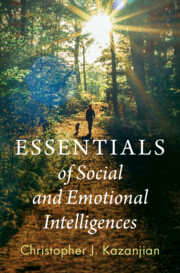265 results
Chapter 10 - Spirituality
-
- Book:
- Essentials of Social and Emotional Intelligences
- Published online:
- 25 March 2025
- Print publication:
- 27 March 2025, pp 215-246
-
- Chapter
- Export citation

Essentials of Social and Emotional Intelligences
-
- Published online:
- 25 March 2025
- Print publication:
- 27 March 2025

Making Places Sacred
- New Articulations of Place and Power
-
- Published online:
- 14 March 2025
- Print publication:
- 10 April 2025
-
- Element
-
- You have access
- HTML
- Export citation
Rethinking Human-Nature Relationships in the Time of Coronavirus: Postmodern Animism in Films by Miyazaki Hayao & Shinkai Makoto
-
- Journal:
- Asia-Pacific Journal / Volume 18 / Issue 16 / August 2020
- Published online by Cambridge University Press:
- 14 March 2025, e6
-
- Article
- Export citation
Reclaiming ritual in palliative care: A hermeneutic narrative review
-
- Journal:
- Palliative & Supportive Care / Volume 23 / 2025
- Published online by Cambridge University Press:
- 27 January 2025, e49
-
- Article
-
- You have access
- Open access
- HTML
- Export citation
Teaching death, spirituality, and palliative care to university students: Novel pedagogical approach
-
- Journal:
- Palliative & Supportive Care / Volume 23 / 2025
- Published online by Cambridge University Press:
- 24 January 2025, e36
-
- Article
-
- You have access
- Open access
- HTML
- Export citation
Cognitive therapy for moral injury in post-traumatic stress disorder: integrating religious beliefs and practices
-
- Journal:
- The Cognitive Behaviour Therapist / Volume 18 / 2025
- Published online by Cambridge University Press:
- 09 January 2025, e2
-
- Article
-
- You have access
- Open access
- HTML
- Export citation
Chapter 7 - The Cénacle and the Sacred
-
-
- Book:
- A History of Haitian Literature
- Published online:
- 07 November 2024
- Print publication:
- 21 November 2024, pp 126-142
-
- Chapter
- Export citation
The mediating role of COVID-19 anxiety on the relationship between quality of life and spiritual well-being, and hopelessness: A study on cancer patients
-
- Journal:
- Palliative & Supportive Care / Volume 23 / 2025
- Published online by Cambridge University Press:
- 07 November 2024, e6
-
- Article
-
- You have access
- Open access
- HTML
- Export citation

The Psychology of Religion
- A Social Force
-
- Published online:
- 01 November 2024
- Print publication:
- 31 October 2024
-
- Textbook
- Export citation
1 - The Untold Story of the Psychology of Religion and Spirituality
- from Part One - Introduction
-
- Book:
- The Psychology of Religion
- Published online:
- 01 November 2024
- Print publication:
- 31 October 2024, pp 3-44
-
- Chapter
- Export citation
Mirrors of the Past: Time and Historical Consciousness in Contemporary Western Astrology
-
- Journal:
- Comparative Studies in Society and History / Volume 67 / Issue 1 / January 2025
- Published online by Cambridge University Press:
- 17 October 2024, pp. 223-248
-
- Article
-
- You have access
- HTML
- Export citation

Style and Meaning in Late Antique Art
- Ancients and Moderns on Seeing and Thinking
-
- Published online:
- 15 August 2024
- Print publication:
- 08 August 2024
Spiritual care interventions for palliative care patients: A scoping review
-
- Journal:
- Palliative & Supportive Care / Volume 22 / Issue 5 / October 2024
- Published online by Cambridge University Press:
- 13 August 2024, pp. 1449-1468
-
- Article
-
- You have access
- Open access
- HTML
- Export citation
13 - Substance Use Disorder Treatment and Recovery with LGBTQ+ Populations
- from Part III - Assessment and Treatment in LGBTQ+ Affirmative Counseling
-
-
- Book:
- LGBTQ+ Affirmative Counseling
- Published online:
- 31 October 2024
- Print publication:
- 04 July 2024, pp 233-248
-
- Chapter
- Export citation
2 - On Being Religious without Knowing It
-
- Book:
- Conversations with the Turtles
- Published online:
- 26 September 2024
- Print publication:
- 13 June 2024, pp 5-17
-
- Chapter
- Export citation
7 - The Post-war Golden Generation, 1945–1965
- from Part II - Networks
-
-
- Book:
- The Cambridge Companion to Australian Poetry
- Published online:
- 06 June 2024
- Print publication:
- 13 June 2024, pp 119-133
-
- Chapter
- Export citation
Chapter 5 - American Spirituality
-
-
- Book:
- The Cambridge Companion to American Utopian Literature and Culture since 1945
- Published online:
- 09 May 2024
- Print publication:
- 16 May 2024, pp 100-114
-
- Chapter
- Export citation
7 - Quantum Mechanics and Our View of Reality
- from Part I - A Nonmathematical Exposition of Quantum Mechanics and Quantum Field Theory
-
- Book:
- Interpreting Quantum Mechanics
- Published online:
- 09 May 2024
- Print publication:
- 16 May 2024, pp 93-110
-
- Chapter
- Export citation
Chapter 1 - Solitude Is Not Just for Hermits, Poets, and Billionaires
-
- Book:
- Solitude
- Published online:
- 24 March 2024
- Print publication:
- 18 April 2024, pp 11-33
-
- Chapter
-
- You have access
- HTML
- Export citation


